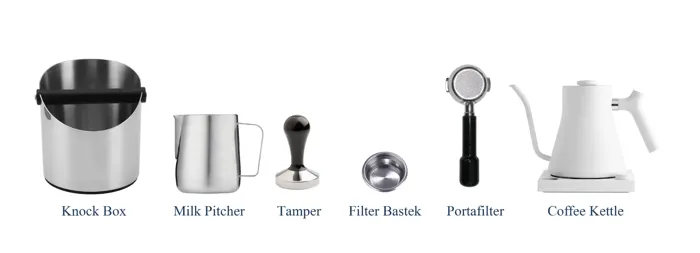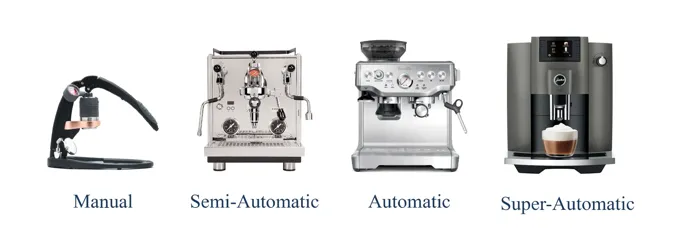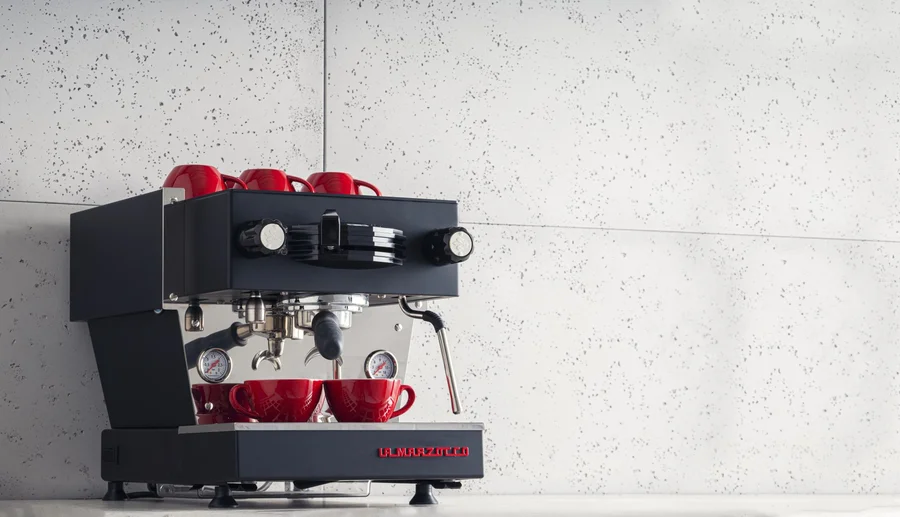Top Espresso Machines Brands Based In switzerland Brands
Here's what we recommend for:
Product Selection
4.9/5
Nespresso Espresso Machines redefine simplicity and convenience in coffee brewing. Known for their user-friendly approach, Nespresso offers a diverse product selection that caters to different tastes and lifestyles. The machines, often featuring compact designs, utilize Nespresso's unique coffee capsules, ensuring a hassle-free and consistent brewing experience.
Availability
5/5
These machines can be found in a variety of retail channels, including dedicated Nespresso boutiques, major appliance stores, and online platforms. Nespresso's commitment to convenience extends beyond the coffee-making process to the purchasing experience, ensuring that customers can effortlessly find and acquire their preferred machine.
Design/Look
4.9/5
Nespresso Espresso Machines are characterized by their modern and sleek design, blending style with practicality. Exhibiting a minimalist aesthetic, these machines often feature clean lines, compact profiles, and premium finishes. The design is not only visually appealing but also emphasizes user-friendly elements, with intuitive buttons and accessible controls. Nespresso pays attention to detail, creating espresso machines.
Affordability
4.5/5
Nespresso Espresso Machines offer a range of pricing options to suit different budgets. The pricing varies based on the model and features, with entry-level machines providing an affordable introduction to the Nespresso experience, while higher-end models may offer additional functionalities and design elements. Nespresso's commitment to quality and convenience is reflected in the value these machines provide at their respective price points.
Affordability
3/5
Jura machines are positioned in the premium market segment, typically ranging from $1,600 to $6,000. While the initial investment is higher compared to some other brands, all models feature built-in grinders, offering convenience and ensuring freshly ground coffee for each cup. The advanced features, high-quality materials, and automation provided by these machines offer significant value over time. While Philips, at some points, offer same technology with a slightly lower price. But...
Build Quality & Durability
4.8/5
Jura is renowned for its exceptional build quality, utilizing high-grade materials. This robust construction ensures longevity and reliability, with many models designed to withstand high volumes of use. The attention to detail in design and manufacturing reflects Jura's commitment to quality. With durable components and thoughtful engineering, Jura machines are built to last, making them a worthwhile investment for those seeking a reliable, long-lasting espresso machine.
Range of Machines
3/5
Jura exclusively offers fully automatic espresso machines, including premium models such as the Z8, Z10, and X10. These machines cater to various preferences with an emphasis on automation and consistency. While Jura offers a more focused range compared to some other brands, each model is built to provide café-quality espresso with minimal effort, making it ideal for those seeking a high-end, automated coffee experience.
Design & Appearance
4/5
Jura machines have a sleek, modern design with stainless steel finishes, aluminum accents, and plastic components. Some models also include a glass milk container, adding a premium touch and enhancing the overall visual appeal. Their design is well-suited for contemporary, minimalist kitchens, where both style and functionality are prioritized.

Perfect for Hands-Off Users: Exclusive focus on fully automatic machines

High-Resolution Displays: Easy-to-use interface and personalization

Superior Auto-Cleaning: Minimal maintenance and descaling effort

Exclusive Technologies: Pulse Extraction Process (P.E.P.) and Pre-Brew Aroma System (I.P.B.A.S.©)

High Price Point: Positioned in the premium market segment

Large Size: Some models require significant counter space

Limited Manual Control: May not appeal to users seeking a hands-on experience
Everything You Need to Know
About Home Espresso Machines
Love that first sip of espresso in the morning? Why not bring the café experience to your kitchen? A good home espresso machine can turn your home into your personal barista station, and we’re here to help you find the perfect one! This guide breaks down everything you need to know about home espresso machines—from how they work to the key features you should keep in mind when picking your new coffee companion. Get ready, we’ve got tips to help you make the perfect espresso right at home.
How Espresso Machines Work
An espresso machine is designed to brew coffee by forcing pressurized water through finely-ground coffee beans. The process results in a concentrated shot of coffee, known as espresso.
Here’s a quick overview of the key components involved in the brewing process:
Portafilter: The handle and basket where the coffee grounds are placed.
Boiler: Heats the water to the ideal brewing temperature.
Pump: Creates the pressure required to force hot water through the coffee grounds.
Group Head: Where the portafilter attaches to the machine, directing the pressurized water through the coffee grounds.
By controlling these components, espresso machines ensure a perfect cup of espresso.

Types of Espresso Machines
There are four main types of espresso machine, each offering different levels of control, automation, and price. Here's a breakdown:
Manual Espresso Machines
As the most traditional type of machine, manual espresso machines are not the focus of our discussion. They use a lever to apply pressure, which the user must operate by hand, and they don’t consume electricity.
Semi-Automatic Espresso Machines
Similar to the machines commonly found in cafés, they offer a balance between control and convenience. The user is responsible for grinding, tamping, and adding coffee to the portafilter, while the machine automatically handles temperature, pressure, water flow, and the brewing process. These machines allow you to customize your espresso experience.
Automatic Espresso Machines
With automatic machines, you need to prepare the portafilter and press a few buttons. The machine handles the tamping, brewing, timing, and sometimes even the milk frothing.
Super-Automatic Espresso Machines
Super-automatics are the most advanced. You only need to press a button. They grind the beans, tamp, brew, froth milk, and even clean themselves. It gives you the most comfort but no customization or control.

Key Features to Look For
When shopping for an espresso machine, there are several important features to consider to ensure you’re getting the best machine for your needs:
Pressure and Pump Systems
Espresso requires a consistent pressure of around 9 bars to extract the perfect shot. Look for machines with a high quality pump to ensure reliable performance.
Temperature Control
Consistent water temperature is key to brewing espresso. Most machines maintain a steady temperature around 200°F. Machines with PID (Proportional-Integral-Derivative) controllers offer more precise control over temperature.
Steam Wand and Frothing Milk
If you enjoy lattes or cappuccinos, a steam wand is essential. It allows you to froth milk to the perfect texture for your favorite drinks. Some machines offer automatic milk frothing features for added convenience.
Grinder and Grind Settings
A built-in grinder provides fresh coffee grounds every time you brew, but it’s important to look for machines with adjustable grind settings to suit different coffee beans and personal preferences.
Drip Tray, Portafilter Size, and Build Quality
A durable build is essential for longevity. Look for machines with stronger materials like stainless steel for better durability. A larger drip tray and portafilter size are also important for larger cups or mugs.
Frequently Asked Questions (FAQs)
What is a hybrid espresso machine?
Hybrid espresso machines offer both manual control and automation, giving users the flexibility to take charge of certain aspects of the brewing process while also offering automated features when you need just convenience.
What’s the difference between milk frothing systems?
Manual Frothing: This system requires the user’s full control and attention, as it works with a steam wand. It needs a learning curve and some skill, but gives the best froth and foam texture.
Semi-Automatic Frothing: These systems allow you to choose the amount of the milk, temperature and foam level but automatically perform the operation and froth the milk. They give you a bit more control over the final result.
Fully Automatic Frothing: Just fill up the milk container! These systems fully automate the frothing process based on the beverage type and pre-programmed functions. It doesn’t offer much customization but ensures consistency and ease of use.
What is a bean-to-cup machine?
Bean-to-cup machines aren't a separate category, but rather a feature that can be found in some automatic espresso machines. These machines are equipped with a built-in grinder that grinds the beans, then automatically transfers the ground coffee to the portafilter and starts the brewing process.
How often should I clean my espresso machine?
Regularly cleaning your espresso machine is essential for maintaining its performance.
Cleaning the group head, rinsing the portafilter or wiping the steam wand is necessary after each use. However deep cleaning, such as descaling or backflushing, should be done every few months or according to your machine's manual.
Do I need to use filtered water for my espresso machine?
We strongly recommend using filtered or bottled water in your espresso machine. It improves the flavor of your espresso while also preventing mineral buildup inside the machine and keeps your machine in good condition. Hard water can lead to scaling, which can reduce your machine’s efficiency and lifespan.
How do I know when it’s time for a deep cleaning of my espresso machine?
For deep cleanings, such as descaling or backflushing, most machines have a reminder or indicator light that alerts you when it's time. Typically, this should be done every 2-3 months, depending on water hardness and usage frequency, though you can also follow the guidelines in the machine's manual.
What is PID control in espresso machines?
PID (Proportional-Integral-Derivative) control is a system that precisely manages the temperature, and ensures water remians consistently stable.
If the temperature drops below the ideal level, the PID system prevents brewing operation, and activates the heating elements until the water reaches the optimal range.
Sometimes delays the brewing but this helps prevent poor extraction.

Can I use capsules in espresso machines?
In some espresso machines, commonly known as all-in-one machines, using capsules is an option, but most machines do not support this, as they operate on different systems. For more details on capsule-based machines, check out our Single-Serve Espresso Machines page.
KEEP READING

















